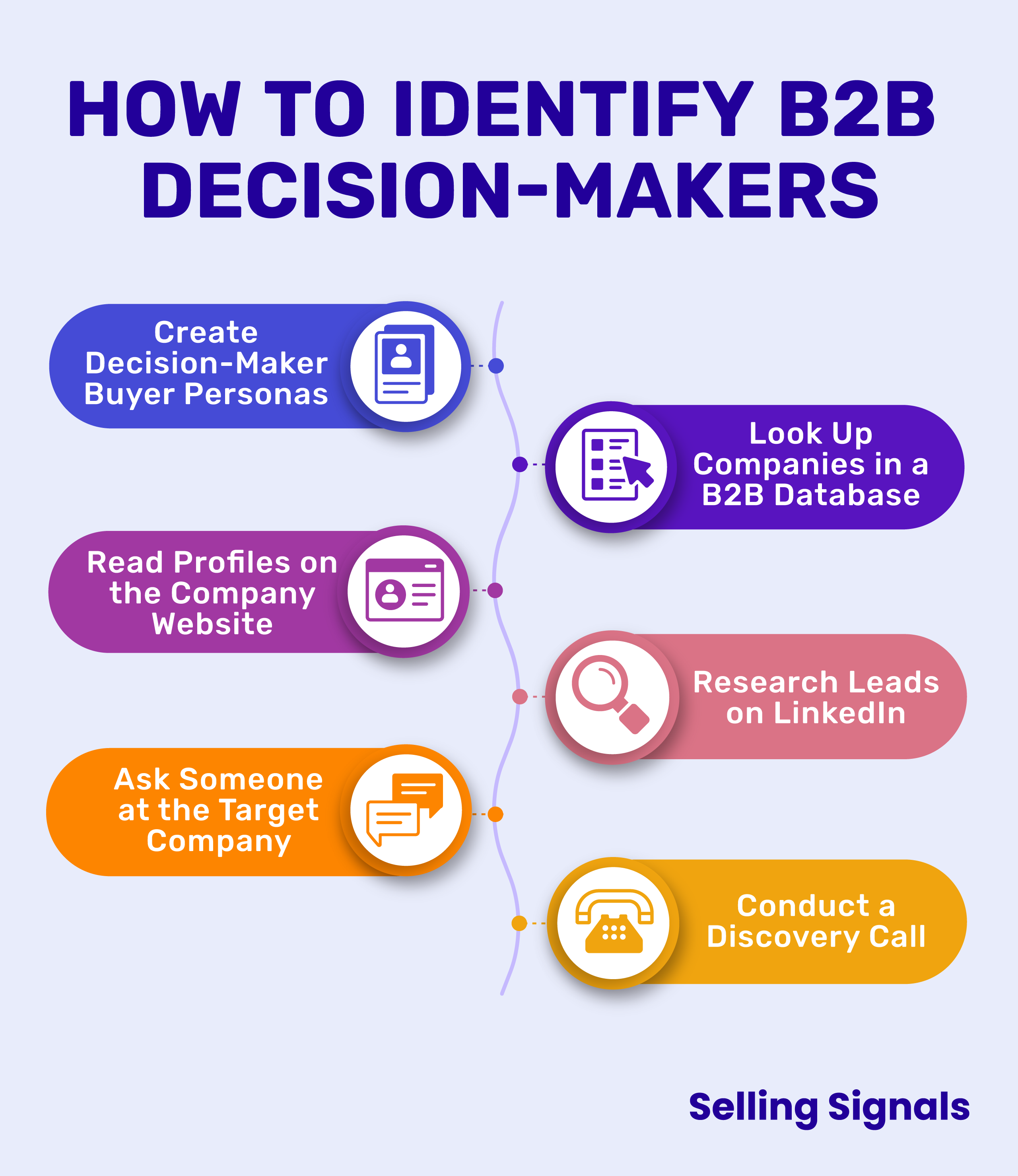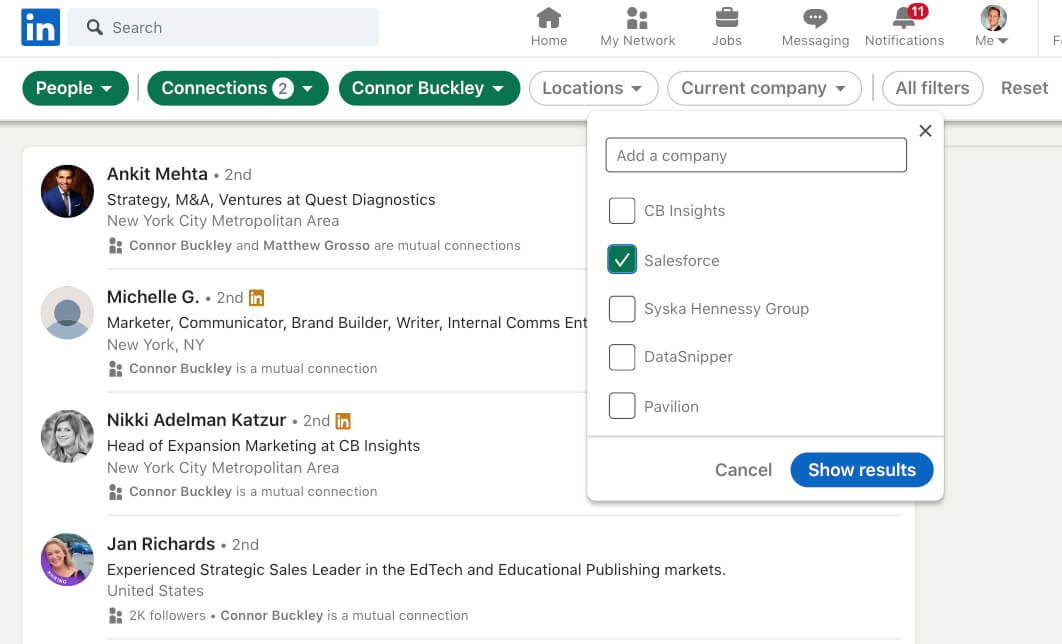-
News & Trends -
Sales -
Marketing Related Topics -
B2B Software Guides Related Topics -
Free Tools & Resources -
- About Us About Us


In B2B sales, a company’s decision-makers are the people with the power to buy your product or service. Identifying them in target companies is essential if you want high-quality leads, fruitful sales meetings, and fast, successful sales cycles. On the other hand, targeting employees with little decision-making authority can be a recipe for wasted time and lost deals. Fortunately, there’s a process you can follow to consistently find a company’s decision-makers.
A decision-maker is anyone at a target company who has the authority to make, or significantly influence, the final decision about investing in your product or service. In B2B sales, there are typically several decision-makers at each account because the details of the purchase’s impact are too nuanced for one person to fully grasp. Multiple people, each with different domains of expertise, must participate in the evaluation to ensure a solid decision.
That said, in every sale, there is usually one leading decision-maker: the one who has the most purchasing power. In many cases, this is the head of a department who controls the department's budget. If you can only target one person in the company, it should be them. They have the perfect mix of power and department knowledge. In other words, their judgment is trusted by the C-suite, and they’re familiar with the challenges your product or service solves.
The process for identifying decision-makers in a company can be broken down into six steps:

If you follow the above process, you’ll dramatically increase the odds of nurturing the right leads at your target companies. This results in higher conversion rates and shorter sales cycles, not to mention freedom from that dreadful feeling of having wasted your time.
As we mentioned above, there is typically more than one decision-maker in a B2B sale. Below we’ll go over the four types — leading, financial, end-user, and admin. It’s important to recognize the different types because each has a unique set of priorities and interests, which you’ll need to understand to effectively convince them that your solution is right for them. Knowing the four types also helps you spot decision-makers you might’ve otherwise ignored.
This is the person leading the evaluation. Often, the leading decision-maker is a department head who controls the budget, commonly VPs or SVPs. This decision-maker has the most responsibility in the evaluation. If the investment fails, it’s on them. It’s like a general manager in sports accepting or denying a trade: The coach and owner have input, but in the end, it’s up to the GM to decide if the trade is the right choice — and they’ll be the one judged for its outcome.
Keep in mind that, even if you don’t personally interact with one of the aforementioned decision-makers during a sale, they’re likely still involved in the evaluation process — if only from the background. That said, make sure to give your point of contact the information they need to bring these decision-makers onto the side of “Yes!”
There is a step-by-step process you can follow to find B2B decision-makers. It involves creating buyer personas, using B2B databases, conducting online research on LinkedIn and company websites, and holding discovery calls with potential decision-makers. The process is meant to be followed in order, but you may need to skip steps or perform them out of order to satisfy the nuances of your investigation.
The first step in finding business decision-makers is to create a buyer persona for each of the types you typically encounter. A buyer persona is a fictitious representation of your decision-maker that’s based on your customer profile. It includes their name, job description, pain points, goals, hobbies, and other traits that will help you identify these decision-makers during your search. You’ll likely need a persona for each decision-maker type, like “Administrative Annie” or “C-Suite Carlos.”
To create a decision-maker buyer persona, follow these steps:
Armed with a buyer persona, whenever you find someone at a company you think might be a decision-maker, simply compare them to the persona to see if there’s a match. As an added advantage, the buyer persona will also help you sell to them in a personalized manner. For example, if the end-user buyer persona indicates that your end-user decision-makers often care a lot about ease of use, you could focus on this in your sales emails and cold calls to them.
We wrote a whole article on this topic — how to create a buyer persona — where you’ll find the entire process for creating them, as well as some templates you can use.
Sometimes referred to as prospecting tools, B2B database software contains data about B2B companies and the professionals working at them. These searchable databases enable you to quickly find potential decision-makers, along with their contact info. Simply search for your target companies by name, or filter for companies that meet your specifications. From there, you’ll be able to find the names and details of contacts working at those companies.
Here are the three best B2B database tools:
B2B sales intelligence tools typically offer an advanced filtering feature. This allows you to find decision-makers in bulk by generating long targeted lists of contacts who fit your buyer persona and are from accounts that match your ideal customer profile. Sales triggers are another handy feature that can be set up to notify you when certain employees change job titles or get promoted — a telltale sign of a shift in the company’s decision-making landscape.
Check out our article on the best B2B database software to learn about the top platforms for finding high-quality leads.
The company website of a target account often has information about the organization’s leaders, either on a Leadership, Team, or About Us page. At the very least, the website should tell you the names and titles of VPs and executives. This is a good starting point for your investigation (you can always find more on LinkedIn). Some companies provide in-depth profiles of their employees that disclose their key responsibilities, education, professional experience, and more.
For example, check out how much intel PowerHouse Property Management provides about two high-level employees who are likely good decision-makers to target:

The amount of information you’ll be able to find about a company’s decision-makers on its website often depends on your industry. Some are more forthcoming than others, especially those in professional services, since they know customers want to evaluate the people they’ll be working with. If you’re selling into a tech company, however, it might be better to skip straight to LinkedIn for your research.
By now you’ll have a list of potential decision-makers, but you may still need to do a bit more research on them if you don’t have a full picture of the target department’s decision-making hierarchy and key players. LinkedIn is a great tool for solving these two challenges. It can give you insights into a potential decision-maker’s past experiences, years at the company, and their roles and responsibilities, all of which help you compare these individuals to your buyer personas.
LinkedIn’s Connections Search feature also empowers you to quickly find other employees who work with your decision-makers. For example, if you know the name of the VP of sales, you might stumble across the sales director and sales manager while sifting through their company connections.
Here’s a screenshot of LinkedIn’s Connection Search in action:

LinkedIn becomes even more helpful for finding decision-makers if you upgrade to LinkedIn Sales Navigator. The Lead Builder feature allows you to narrow down your lead search to people on LinkedIn who fit your buyer persona criteria. You’re able to filter by location, keywords, function, title, company, industry, and even seniority level and experience. You’re basically plugging in your buyer persona and then finding leads on the platform who fit it.
If these methods fail to provide results, you can always fall back on the age-old method of calling the company’s main number and asking the gatekeeper (often an office manager or assistant) for advice about who to speak with. After engaging in a bit of small talk and telling them who you are and where you work, ask them if they know who’s in charge of making purchasing decisions regarding products or services like yours.
If they aren’t sure, ask them to point you in the direction of the person in charge of the department you generally sell into. When they forward your call to the department, you might find that this person is not a decision-maker, and so the process repeats until you reach the decision-maker or get blocked by a gatekeeper. The best way to avoid getting blocked is to always be upfront about who you are and why you’re calling, and to be friendly and considerate.
If the company has no clear-cut departments, ask a question related to a strong indicator of decision-making status. When I sold a property tech solution, I used to ask, “Who is the person in charge of managing building operations on a day-to-day basis?” since this person often made a great internal champion and thus an ideal first contact in the sale.
If you’ve identified and sparked interest in a potential decision-maker, hold a discovery call where you ask them some qualification questions to ensure they have the authority to heavily influence the buying decision. Also, ask them if there are other stakeholders you should involve in the sales process. Note that, in addition to authority, there are other qualification factors to assess, such as budget, needs, and timeline, so ask questions about those as well.
Here are some questions you can ask to assess authority and identify other decision-makers:
After the call, compare their answers to the information in your buyer personas. Do they match any of the decision-maker types you’ve outlined? If so, you’ve found a decision-maker — congratulations. Now go and research the other contacts the lead mentioned. Compare them to your buyer persona and match them to one. That way, when the lead invites them to the next meeting, you’ll have an idea of what matters to them.
Now that we’ve covered how to find B2B decision-makers and turn them into leads, let’s go over some best practices that are applicable throughout the target company research process.
Below are three tips for finding decision-makers to keep in mind as you progress through the steps above. They include showing all employees the respect you show decision-makers, avoiding a reliance solely on job titles, and asking your point of contact if there are other people to include in your meetings.
For all you know, the C-suite executive you’ve been courting could leave their on-the-fence decisions up to their assistant, whom they believe to be a great judge of character. If you were dismissive or impolite to said assistant, you’d lose the sale. Always treat everyone, even if it’s a college intern who brought you coffee in your meeting, with the respect that you would give a decision-maker. You never know whether or not they have the decision-maker’s ear.
A CMO at Company A might have a completely different set of responsibilities than one at Company B. And Company C might not even have a CMO, since they’re on the smaller side. Relying on job titles as your only indicator of decision-making status can be misleading, and may result in you overlooking key decision-makers or wasting time pitching to people too high up the ladder. Research each potential decision-maker beyond their job title, and make sure you target several different job titles.
It’s common for busy professionals to forget to include an important colleague in a vital step of the evaluation process. To avoid missing out on a chance to sell to these decision-makers, get into the habit of asking, “Is there anyone else we should involve in this meeting?” It’s better to have these influential people in your meetings and demos than to rely on your point of contact to relay the message to them later. At the very least, it saves you from having to do the meeting twice.
If you follow these tips and the process we’ve given you, finding B2B decision-makers and nurturing them to a close should become a whole lot easier.
In B2B sales, finding the decision-makers is often the first part of the lead generation process. To start selling, you need to know who to target. If you follow the process we’ve outlined in this article, you’ll consistently identify and engage with the right people at your target companies, and you’ll win more sales as a result. To learn more about attracting leads to your offer and qualifying them, check out our ultimate guide on lead generation.


Sam is a former SaaS sales rep turned freelance writer. He spent his career selling real estate technology to C-suite executives before switching over to blogging, where he now covers sales, marketing, and small business topics. Sam specializes in lead generation, lead nurturing, and deal closing articles for Selling Signals. When he’s not researching the latest sales trends, he’s either penning short stories, hiking, or reading in NYC’s Washington Square Park.

Selling Signals delivers actionable advice for sales and marketing professionals. Learn strategies that help you hit targets, strengthen customer relationships, and win more business. Get expert advice on lead generation, sales processes, CRM software, sales management, and account management directly to your inbox.
Property of TechnologyAdvice. © 2025 TechnologyAdvice. All Rights Reserved
Advertiser Disclosure: Some of the products that appear on this site are from companies from which TechnologyAdvice receives compensation. This compensation may impact how and where products appear on this site including, for example, the order in which they appear. TechnologyAdvice does not include all companies or all types of products available in the marketplace.